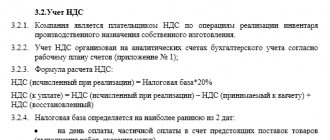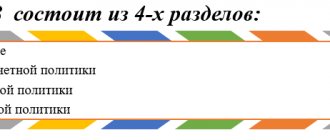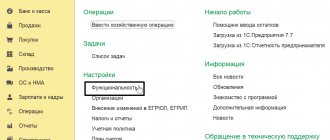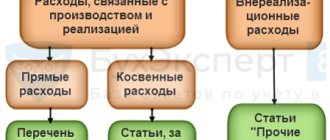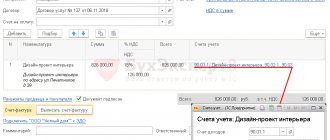Are you switching from UTII? Connect Kontur.Accounting
45% discount in November: RUR 7,590 instead of 13,800 rub. per year of work
Easy bookkeeping
The system itself will calculate taxes and remind you of the deadlines for payments and submission of reports.
Automatic calculation of salaries, vacation pay and sick leave
Technical support 24/7, tips inside the service, reference and legal database
Sending reports via the Internet
Reports and KUDiR are generated automatically based on accounting data
Electronic document management and quick verification of counterparties
Documents, transactions, analytical reports, VAT reconciliation
In accordance with Art. 126 of the Tax Code of the Russian Federation, for the absence of a software package, the company is held accountable in the form of a fine of 300-500 rubles. Failure to comply with the rules of the UP is equivalent to gross violations of the requirements regulated by Art. 120 of the Tax Code of the Russian Federation and entail penalties in the form of penalties from 10,000 rubles.
Regulatory framework governing UE: Federal Law No. 402 - Federal Law “On Accounting”, Accounting Regulations No. 34 - n, Tax Code of the Russian Federation.
Fundamental principles of UE:
- completeness - all business transactions are subject to mandatory registration;
- timeliness - facts of economic life must be recorded in the period in which they were committed;
- consistency - the data of analytical and synthetic accounting must coincide;
- rationality - costs reflected in accounting must be justified in accordance with the established procedure for the economic activity of the enterprise;
- consistency - the UE should be applied systematically from year to year;
- comparability - changes in the management program are made only from the beginning of the financial year.
Cases of changes to the UP:
- changes in the legislation of the Russian Federation;
- introduction of new ways of organizing and maintaining records;
- changes in the types of activities of an economic entity.
The organization, in parallel with the approval of the UE, develops, approves and reflects in the application the following types of documents:
- working chart of accounts of the enterprise;
- forms of primary accounting documents used by the organization;
- document flow schedule;
- accounting and tax registers;
- instructions for organizing and conducting cash transactions;
- methodology for assessing assets and liabilities;
- inventory procedure;
- rules for monitoring the facts of economic life.
Accounting policies: concept and requirements
When creating an organization, a necessary condition for its activities is accounting.
This is prescribed to economic entities of all organizational forms, with a few exceptions (Article 6 of Law dated December 6, 2011 No. 402-FZ). The basic rules for processing data on the economic activities of entities are given in PBU 1/2008 “Accounting Policy of an Enterprise”. This document reflects the requirements for accounting and tax accounting; it is a kind of instruction for displaying the facts of a company’s economic life in value terms, followed by their systematization, preparation and submission of a report. All organizations are required to draw up PBUs.
The accounting policy forms recommendations for the creation of:
- accounting of primary documents,
- document circulation systems,
- asset valuation systems,
- reporting forms for business activities.
Organizations develop it taking into account the requirements of PBU 1/2008 (Order of the Ministry of Finance dated 06.10.08 No. 106). This takes into account the structure of the company, areas of activity and the adopted taxation regime, and accounting methods. The accounting policy is developed by the chief accountant, and it is approved by order of the manager.
An organization's accounting policies are adjusted when accounting laws change or when ownership changes.
Competent development of accounting policies allows you to:
- maintain the company's document flow at lower costs;
- facilitate accounting through the use of certain techniques;
- optimize the amount of taxes using legal methods.
The registration of accounting policies is carried out in one document with sections in various areas of accounting and tax accounting (materials, taxes, reporting, etc.). It can also provide for the convergence of positions on accounting and tax accounting. To do this, you need to perform the same actions when writing off costs, recording income, accounting for fixed assets, etc.
The developed forms of documents for accounting are also given in this document. There is no requirement for the mandatory use of unified reporting forms in the law of December 6, 2011 No. 402-FZ. The forms that the company will use must be approved by its director.
Thus, the accounting policy allows all structural divisions of the company to work towards the same result, while ensuring a minimum level of costs.
Combination of simplified tax system and UTII
The simplified tax system and UTII are special tax regimes that exempt legal entities from paying corporate income tax, VAT, corporate property tax and exempt individual entrepreneurs from paying personal income tax on business income, VAT and personal property tax in relation to the entrepreneur himself.
In an organization, it is possible to combine two taxation regimes: simplified tax system and UTII. In this case, the company keeps separate records of income, expenses, property and other business transactions separately for each regime. At the same time, all information about separate accounting must be reflected in the enterprise’s UE, since the tax code does not provide clear instructions on distribution.
The simultaneous use of two special tax regimes requires additional detail for accounting and tax accounting data, and for individual entrepreneurs - the distribution of tax accounting information.
UTII will be canceled from January 1, 2021. Organizations and entrepreneurs will no longer be able to combine imputation with a simplified system. Choose an alternative tax regime with the minimum tax burden for your business - our free calculator will help you with this. If you are going to transfer all your activities from UTII to the simplified tax system or another tax regime, read the article - we have collected answers to the most popular questions about the transition from imputation. Didn't find the answer to your question? Ask it in the comments, we will definitely answer.
Accounting policy for LLC with UTII
Accounting policy
The “imputed” organizations are required to keep accounting records, and therefore must have a properly drawn up accounting policy of an accounting nature. The basic rules and principles are reflected in the PBU, however, this document may include several alternative accounting methods, and for some transactions may not have them at all. The task of the LLC is to determine for itself a suitable and convenient way to organize accounting, and to develop the missing methods.
Accounting policy is not just a required formality, but a solution to controversial and ambiguous situations that arise in the process of doing business. That is, this type of policy is necessary, first of all, for the LLC itself.
Accounting policies for accounting should include:
| Policy item | Explanations |
| Working chart of accounts | A list of accounts selected from the existing Chart of Accounts and necessary to fully reflect all required indicators. It is convenient to carry out this plan with a list that includes the necessary accounts and specific sub-accounts for them, which will actually be used and will allow you to separately take into account the necessary indicators for calculating taxes for different types of business (it is on sub-accounts that it is most convenient to keep separate records). |
| The procedure for assigning various indicators between subaccounts | Rules for organizing separate accounting for different types of business. |
| Forms of primary documentation | Forms that will be used by the company (unified or personally prepared). Samples of self-prepared forms should be included in the policy. |
| Register forms | We independently develop consolidated registers designed to transfer data from primary documentation. Must take into account transactions for each type of business. |
| Accounting for intangible assets and fixed assets | Installed:
|
| Accounting for inventory and products | Defined by:
|
| Income, expenses | Features of accounting for commercial and administrative expenses, nuances of revenue recognition. |
If the company is a small entity, then accounting can be significantly reduced by writing in the accounting policy principles that simplify accounting and reporting - reduce the work plan by combining some accounts, abandon some PBUs, submit reports in a simplified form. All these points need to be written in the LLC policy.
Tax policy of LLC under UTII
The policy under consideration for UTII is mandatory for an LLC; it must be formed in such a way as to ensure the correct calculation of tax. For this reason, the policy must define the methods and rules by which the company's tax liability will be calculated.
First of all, tax accounting should reflect separate accounting of indicators. How to do this is determined by the company independently, since tax laws do not clearly define this. The main thing is that the principles enshrined in the policy make it possible to correctly calculate the single special tax and other tax obligations.
An accounting tax policy will be needed for UTII even if separate accounting is not needed due to running only one type of business. At the same time, it includes the type of activity, the physical indicator for it, the procedure for calculating the special tax, and accounting for insurance payments when reducing the tax payable.
Accounting policies for tax purposes include:
- Activities;
- A set of physical indicators that will be used when calculating the tax burden;
- The procedure for distributing these indicators when calculating a single special tax (for example, a company sells retail and repairs clothes in the same premises, these are different types of business for which it is necessary to determine how the premises area will be distributed between them);
- Method of separate accounting with simultaneous operation in different modes;
- Tax register forms required to reflect the required indicators are subject to independent development, taking into account the specifics of conducting business;
- Accounting for insurance premiums in order to reduce tax payable.
This policy comes into force from the beginning of the year, that is, it must be formed and approved before the end of the year in order to begin its application from January next. If the period for its application is not defined, then the policy is valid until the end of the business. It is convenient to make adjustments using separate administrative documents without changing the original document.
Combination of special regimes for a legal entity
Simplified accounting involves reducing accounting accounts by combining them. However, unification is impossible with separate accounting, since it does not enlarge the indicators, but, on the contrary, their specification:
- analytical income distribution;
- distribution of direct costs;
- separate accounting of expenses not related to direct ones, which, according to the accounting policy, are attributed to the financial result or distributed in proportion to the types of activities;
- distribution of personnel according to types of activities;
- division of property by type of activity;
- creation of instructions for the distribution of expenses.
This process should be described in more detail in the order on accounting policies.
The importance of detailing tax accounting will increase given that the company, along with the simplified tax system, will implement several types of activities under UTII. Organization and maintenance of tax accounting will become more complex due to:
- implementation of separate accounting of income;
- maintaining separate accounting of expenses;
- development of a distribution algorithm;
- distribution of personnel according to regimes, especially those registered under UTII, since the number of personnel units is necessary when calculating the imputed tax, it acts as an indicator of basic profitability;
- distribution of property according to regimes, especially those taken into account for UTII;
- distribution of administrative and management staff.
How to keep separate records when combining OSNO and UTII?
Legislative regulation of separate accounting when combining UTII and OSNO
Local regulations on separate accounting - tax accounting policy
Separate accounting for VAT calculation
Separate accounting for calculating income tax
Distribution of premises and areas by type of activity
Consequences of lack of separate accounting
Legislative regulation of separate accounting when combining UTII and OSNO
Separate accounting for OSNO and UTII (the general taxation system and the unified tax on imputed income) when they are combined is provided for by the norms of the Tax Code of the Russian Federation (hereinafter referred to as the Tax Code of the Russian Federation):
- Requirement for UTII payers: according to clause 7 of Art. 346.26 of the Tax Code of the Russian Federation, when simultaneously carrying out activities that are subject to taxation in a different manner, they are required to pay taxes corresponding to other regimes. To do this, it is necessary to take into account separately for each direction:
- property;
obligations;
- business transactions.
- Requirements for persons using OSNO: in accordance with clause 4 of Art. 149 of the Tax Code of the Russian Federation requires separate accounting of transactions for calculating value added tax (VAT), according to paragraphs. 9, 10 tbsp. 274 of the Tax Code of the Russian Federation - a determination of the tax base for income tax, etc., separate from the performance indicators of other areas. More detailed information about taxation under the general regime can be found in the article at the link: Taxation under OSNO - types of taxes.
Read more about reporting in this mode in the article on our website at the link: Reporting on UTII - type of form and submission procedure.
Similar requirements are imposed on individual entrepreneurs (IP), with the difference that instead of income tax, they pay personal income tax (NDFL).
To carry it out, it is necessary to determine the procedure for the actions of the organization’s employees in the appropriate document.
Tax and accounting
The requirements for separate accounting contained in the norms of the Tax Code of the Russian Federation regulate the procedure for organizing, first of all, tax accounting. Another type of accounting is accounting, provided for by the Law “On Accounting” dated December 6, 2011 No. 402-FZ. Accounting organization options:
- optional when keeping records of indicators necessary for taxation - for individual entrepreneurs, divisions of foreign legal entities (clause 1, part 2, article 6 of Law No. 402-FZ);
- the possibility of conducting simplified accounting - for small businesses and some other organizations (Part 4, Article 6 of Law No. 402-FZ);
- full accounting - for other entities.
Unlike accounting, tax accounting is always required (subclause 3, clause 1, article 23 of the Tax Code of the Russian Federation). When opening new areas, it is necessary to determine for them the methods (methods) of maintaining tax accounting (paragraph 7, article 313 of the Tax Code of the Russian Federation).
For this purpose, it is permissible to change accounting registers or create new ones. There are no mandatory forms of accounting documents. In this case, certain minimum requirements established by Art.
313 Tax Code of the Russian Federation:
- Compliance of the accounting system with its functions (the order of formation of indicators, etc.).
- Availability of primary accounting documents, analytical registers, calculation of the tax base.
- Availability of certain details in analytical registers.
Thus, tax accounting is carried out by modifying or expanding accounting indicators or creating a separate accounting system. The selected accounting option is fixed as an accounting policy.
Tax accounting policy
The accounting policy for tax purposes includes (Article 11 of the Tax Code of the Russian Federation):
- ways and methods of accounting and distribution of indicators;
- opened accounts and sub-accounts;
- forms of registers and primary documents, etc.
It is recorded in one document (which may be called: accounting policy) or several, approved by order of the head of the organization or individual entrepreneur.
In a situation where two regimes are combined, the publication of such a document primarily corresponds to the interests of the taxpayer himself. In the absence of separate accounting based on the methods established in the accounting policy, based on the results of a tax audit, additional taxes may be assessed based on the division of income and expenses applied by the tax authority at its discretion.
Thus, in one of the cases, the court indicated that, given the gap in the regulatory framework for separate accounting procedures, the individual entrepreneur was obliged to approve an accounting policy for tax purposes. In its absence, the proportional distribution of income and expenses made by the tax authority was recognized as legitimate (Resolution of the Supreme Court of the Russian Federation dated March 3, 2021 No. F01-122/16 in case No. A11-371/2015).
Let's look at the features of dividing accounting into 2 main taxes - VAT and income tax.
Norms of the Tax Code of the Russian Federation on separate accounting for VAT
For activities to which UTII applies, the entity is not recognized as a VAT payer. The exception is certain types of transactions, for example import ones (clause 4 of Article 346.26 of the Tax Code of the Russian Federation).
On OSNO, VAT is paid and claimed for deduction. The obligation to separate accounting for transactions subject to and not subject to taxation is enshrined in clause 4 of Art. 149 and para. 5 paragraph 4 art. 170 Tax Code of the Russian Federation.
In paragraph 4 of Art. 170 of the Tax Code of the Russian Federation determines the procedure for handling input VAT:
- if assets are used in transactions falling under OSNO, VAT on them is deductible;
- if the property is involved in non-taxable activities, VAT is taken into account in its value and cannot be deducted.
Some difficulties may arise when distributing VAT between UTII and OSNO.
VAT distribution methods
Purchased goods, in the price of which the supplier includes VAT, can be used for work on both UTII and OSNO. In this case, there may be no physical distribution of property (for example, when using the same equipment or premises). Based on this, the calculation of input VAT for deduction is usually carried out:
- Direct account method - if it is possible to directly distribute property both in the ways established in the accounting policy and according to other documents. For example, the presence of a lease agreement for premises makes it possible to determine their use at OSNO. A similar situation was considered in the resolution of the AS UO dated November 16, 2015 No. F09-8211/15 in case No. A07-1060/2015.
- The proportion method enshrined in paragraph. 4 p. 4 art. 170, clause 4.1 art. 170 of the Tax Code of the Russian Federation, - based on the ratio of the cost of goods shipped (used property) according to OSNO or UTII and the total cost of goods shipped to customers (used property).
The taxpayer may establish a different procedure, for example, based on the distribution of costs in proportion to the revenue received in 2 areas. This method of separate accounting was recognized as legal by the AS VSO in its resolution dated February 27, 2021 No. F02-273/2021 in case No. A33-1251/2021.
Source: https://rusjurist.ru/nalogi/envd/kak_vesti_razdelnyj_uchet_pri_sovmewenii_osno_i_envd/
Combination of tax regimes for individual entrepreneurs
The simultaneous use of UTII and the simplified tax system for an individual entrepreneur is simpler than for an organization, since the individual entrepreneur is not required to keep accounting records. However, an individual entrepreneur must keep tax records separately, and he must also distribute property and employees between tax systems.
Individual entrepreneurs, when combining special regimes, in most cases choose the simplified tax system for the object of taxation “income”, since it is similar to UTII, and, therefore, such a combination is less labor-intensive.
An individual entrepreneur without employees, when combining the simplified tax system at a rate of 6% and UTII, has the right to apply a deduction to one of the taxes at the expense of the amounts of paid insurance contributions. An individual entrepreneur with employees on the simplified tax system of 6% and UTII can reduce two taxes up to 50% at the expense of insurance premiums that were paid for all personnel, including the individual entrepreneur himself, taking into account the specifics of the distribution of employees by regime.
Controversy surrounding the 5% barrier
According to para. 9 clause 4 art. 170 of the Tax Code of the Russian Federation, the taxpayer has the right not to apply the provisions of this paragraph (that is, not to distribute “input” VAT) to those tax periods in which the share of total expenses for the acquisition, production and (or) sale of goods (work, services), property rights, transactions for the implementation of which are not subject to taxation do not exceed 5% of the total value of aggregate expenses. In this case, the entire amount of “input” VAT in the named tax period is subject to deduction in accordance with the procedure provided for in Art. 172 Tax Code of the Russian Federation .
I would like to note that the issue of the 5% barrier for “imputers” can currently be considered unresolved. The fact is that back in 2005, the regulatory authorities issued letters. From them it followed that the norm provided for in paragraph. 9 clause 4 art. 170 of the Tax Code of the Russian Federation , is applied only by VAT payers, and organizations that are payers of UTII in relation to certain types of activities and for which during the tax period the share of total costs for the production of goods (works, services) sold within the framework of activities subject to UTII does not exceed 5 % of the total amount of total expenses does not have the right to deduct the amount of “input” VAT in full (see letters of the Ministry of Finance of Russia dated July 8, 2005 No. 03-04-11/143 , Federal Tax Service of Russia dated May 31, 2005 No. 03-1-03 /897/ [email protected] , dated 10/19/2005 No. MM-6-03/ [email protected] ). Unfortunately, no later clarifications could be found. There are individual examples in arbitration practice where judges expressed a similar opinion (see, for example, Resolution of the FAS TsO dated May 29, 2006 No. A23-247/06A-14-38 ).



